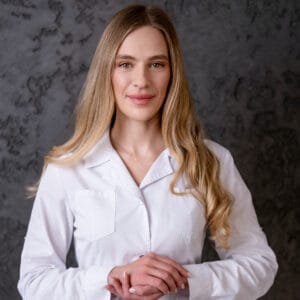Ultrasound diagnostics

Ultrasound diagnostics: types, advantages, and features of the procedure
Ultrasound examination is one of the most informative methods for diagnosing diseases of internal organs and soft tissues. It provides visualization of the studied structures and allows for the assessment of their anatomical features. Specifically, it can detect manifestations of various diseases, injuries due to trauma, congenital anomalies, or neoplasms. Modern devices ensure high quality and clarity of images, enabling the doctor to see the smallest pathological changes and diagnose the disease at an early stage.
Ultrasound diagnostics (US) are widely used in both adults and children. The procedure is non-invasive, safe, and completely painless.
What is ultrasound diagnostics (US)?
The tissues of the human body can transmit and reflect ultrasound waves. This property forms the basis for the operation of ultrasound diagnostics. The device emits ultrasound waves with a frequency of over 20 kHz. These waves pass through the tissues and are reflected by them, after which the device’s sensor captures them and transmits the data to a computer. A special program processes the obtained information and generates an image displayed on the monitor.
Since the degree of conductivity of ultrasound waves through certain tissues varies, clear outlines of organs are formed on the screen, along with areas of different shades. By evaluating the image, the specialist determines a range of characteristics and checks their conformity to the norm. In case of detecting any changes, they provide a detailed description.
Оскільки ступінь провідності УЗ-хвиль певними тканинами відрізняється, на екрані формуються чіткі контури органів і з’являються ділянки із різним ступенем забарвлення. Оцінюючи зображення спеціаліст визначає ряд характеристик і перевіряє їх відповідність нормі. У разі виявлення змін детально їх описує.
Why I.D.CLINIC
Doctors
Reviews.
Софія
Прийом сподобався, дуже хороший лікар, добре все пояснив
Відгук від партнерів doc.ua
Уляна
Лікар гарний, молодший персонал кваліфікований. Буду записуватись в майбутньому. Дякую!
Відгук від партнерів doc.ua
Маргарита
Лікар дала відповіді на всі мої запитання.Все добре пройшло.
Відгук від партнерів doc.ua
Тетяна
Приємно було знаходитися на візиті.
Відгук від партнерів doc.ua
Іванна
Дуже гарний, професійний лікар. Мене все задовольнило на візиті.
Відгук від партнерів doc.ua
Types of ultrasound diagnostics:
In our medical center, new equipment has been installed, and highly qualified specialists are working.
Thanks to this, almost all types of ultrasound diagnostics are performed in the ultrasound diagnostics room:
- Pregnancy ultrasound – allows confirming pregnancy and determining its duration, monitoring fetal development at various stages, and finding out its sex;
- Abdominal organ ultrasound – includes examination of the pancreas, liver, spleen, gallbladder, and bile ducts, and allows detecting tumors, inflammatory diseases, hepatitis, cirrhosis, and other pathologies;
- Ultrasound of the abdominal cavity and retroperitoneal space – in addition to examining the abdominal organs, includes assessment of the kidneys and bladder, helping to identify diseases of these organs;
- Breast ultrasound in women – used for detecting mastopathy, mastitis, cysts, tumors, and other pathologies;
- Breast ultrasound in men – prescribed in case of suspicion of gynecomastia or tumor development;
- Pelvic organ ultrasound in women (vaginal/abdominal access) – includes a wide range of diagnostics;
- Pelvic organ ultrasound in men – involves examination of the bladder, prostate, and helps diagnose prostatitis and other male diseases;
- Folliculometry – performed to monitor the development of follicles in the ovaries;
- Cervicommetry – allows measuring the length of the cervix, which is significant for assessing the risk of premature birth;
- Thyroid ultrasound – allows evaluating the size and structure of the organ, diagnosing cysts and other tumors;
- Kidney and adrenal ultrasound – prescribed for diagnosing diseases and assessing treatment effectiveness;
- Bladder ultrasound – helps detect urolithiasis and other pathologies of the organ;
- Kidney and bladder ultrasound – prescribed in case of suspected diseases of the urinary system, as well as for evaluating the effectiveness of therapy;
- Prostate and bladder ultrasound with residual urine measurement – performed for men to diagnose diseases of the urogenital system;
- Scrotum and testicle ultrasound – performed for men in the presence of symptoms of diseases of these organs;
- Prostate ultrasound (rectal/abdominal access) – allows assessing the condition of the prostate, detecting hyperplasia and other pathologies;
- Ultrasound of lymph nodes in various locations – allows evaluating the size and structure of lymph nodes and detecting changes characteristic of inflammatory processes and oncological diseases;
- Joint ultrasound of the upper or lower limbs (paired) – allows diagnosing inflammatory and degenerative diseases, as well as injuries due to trauma;
Advantages of ultrasound diagnostics (US):
Ultrasound diagnostics (US) is a modern examination method widely used in various fields of medicine.
Its main advantages are:
- High informativeness – the ability to quickly obtain accurate information about the condition of internal organs and soft tissues;
- Non-invasiveness and painlessness – the examination causes no discomfort and takes little time;
- Safety – ultrasound waves do not have a negative impact, allowing examinations to be conducted even on children and pregnant women;
- Affordability – ultrasound diagnostic types have a low cost, making them accessible to all patients in the ultrasound room.
How to prepare for ultrasound diagnostics?
The preparation for ultrasound diagnostics varies depending on the organs to be examined. In particular, it is necessary to refrain from eating and to arrive fasting at the ultrasound diagnostic center if an examination of the stomach, pancreas, liver, spleen, gallbladder, and its ducts is planned.
Before the examination of the bladder, it may be recommended to drink several glasses of water. Breast diagnostics and pelvic organ examinations in women may be scheduled for a specific day of the menstrual cycle.
For ultrasound examinations of soft tissues, blood vessels, the thyroid gland, heart, kidneys, adrenal glands, prostate, lungs, salivary glands, and some other organs, no preparation is needed.
Reasons for ultrasound diagnostics.
For the examination, the patient lies on their back, side, or stomach. The doctor applies gel to the skin, which improves the contact between the sensor and the body, allowing the ultrasound waves to pass through. The doctor then slowly moves the sensor across the skin, obtaining images of the examined organ. The doctor carefully examines it and checks the relevant characteristics, recording the results in a report.
The procedure is painless: the patient may only feel coolness from the gel and slight pressure from the sensor.
The examination typically takes an average of 15 minutes to half an hour.
Results of ultrasound diagnostics.
Ultrasound of organs and the interpretation of the examination results are conducted by a specialist in ultrasound diagnostics. They analyze the data obtained during the examination and check for compliance with normal values. If pathological changes are detected, they provide a detailed description in the report.
The specialist conducting the ultrasound usually does not make a diagnosis but only describes the recorded changes. After receiving the report, it is advisable to consult the doctor who ordered the examination. They will evaluate the results of the ultrasound and other tests, as well as consider the symptoms and medical history, to provide an appropriate diagnosis and prescribe treatment.
Ultrasound diagnostics is a highly informative, safe, and painless method of examination. To obtain the most accurate results, the study should be conducted using modern equipment that provides high-quality images. This allows experienced specialists to detect even the smallest deviations from normal values, enabling early diagnosis of diseases.
To undergo an examination, schedule an appointment at our ultrasound diagnostic center.
Prices
Ultrasound of the knee joint for children
Uzd diagnostics
800 грн
Ultrasound of hip joints
Uzd diagnostics
950 грн
Ultrasound of the elbow joint for children
Uzd diagnostics
750 грн
Ultrasound of the adrenal glands in children
Uzd diagnostics
550 грн
Ultrasound of kidneys and adrenal glands in children
Uzd diagnostics
800 грн
Ultrasound of kidneys in children
Uzd diagnostics
650 грн
Ultrasound of the portal system in children
Uzd diagnostics
700 грн
Transabdominal pelvic ultrasound in children
Uzd diagnostics
700 грн
Ultrasound of abdominal organs and kidneys in children
Uzd diagnostics
950 грн
УЗД пілоричного відділу шлунка у дітей
Узд діагностика
700 грн
Ultrasound of pleural cavities in children
Uzd diagnostics
700 грн
Ultrasound of the shoulder joint for children
Uzd diagnostics
800 грн
Ultrasound of the bladder with determination of residual urine in children
Uzd diagnostics
850 грн
Ultrasound of the ankle joint for adults (2 legs)
Uzd diagnostics
1400 грн
Adult ankle ultrasound (1 leg)
Uzd diagnostics
800 грн
Ultrasound of lungs and pleural cavities
Uzd diagnostics
1000 грн
Ultrasound of the elbow joint for adults (2 hands)
Uzd diagnostics
1400 грн
Ultrasound of the elbow joint for adults (1 arm)
Uzd diagnostics
800 грн
Ultrasound of pleural cavities
Uzd diagnostics
800 грн
Ultrasound of the shoulder joint for adults (1 joint)
Uzd diagnostics
800 грн
Ultrasound of the shoulder joint for adults (1 joint)
Uzd diagnostics
1400 грн
Ultrasound of the carpal joint for adults (1 arm)
Uzd diagnostics
700 грн
Ultrasound of hand joints for adults (1 hand)
Uzd diagnostics
700 грн
Ultrasound of hand joints for adults (2 hands)
Uzd diagnostics
1200 грн
Ultrasound of the hip joint for adults (1 joint)
Uzd diagnostics
800 грн
Ultrasound of the hip joint for adults (2 joints)
Uzd diagnostics
1400 грн
Ultrasound of lymph nodes in children
Uzd diagnostics
750 грн
Ultrasound of mammary glands in children
Uzd diagnostics
600 грн
Ultrasound of superficial organs and tissues in children
Uzd diagnostics
800 грн
Ultrasound of salivary glands in children
Uzd diagnostics
700 грн
Ultrasound of the thyroid gland in children
Uzd diagnostics
700 грн
Biochemical screening (without ultrasound) PAPR-A and free B-hCG/ I-II trimester
Uzd diagnostics
900 грн
Biochemical screening (without ultrasound) PAPR-A, free B-hCG and PIGF/ 1st trimester
Uzd diagnostics
1650 грн
Duplex scanning of renal vessels
Uzd diagnostics
800 грн
Duplex scanning of abdominal vessels
Uzd diagnostics
900 грн
Duplex scan of vessels: peripheral vessels (arteries or veins) of 2 limbs
Uzd diagnostics
1200 грн
Ultrasound in the 2nd and 3rd trimesters of pregnancy (14-40 weeks)
Uzd diagnostics
1300 грн
Ultrasound in the 1st trimester of multiple pregnancy (11-13 weeks)
Uzd diagnostics
1150 грн
Ultrasound of the knee joint for adults (1 leg)
Uzd diagnostics
800 грн
Ultrasound of the knee joint for adults (2 legs)
Uzd diagnostics
1400 грн
Ultrasound of lymph nodes
Uzd diagnostics
700 грн
Ultrasound of superficial organs and tissues
Uzd diagnostics
700 грн
Ultrasound of the bladder
Uzd diagnostics
550 грн
Ultrasound of the pubic joint
Uzd diagnostics
500 грн
Ultrasound of mammary glands in women
Uzd diagnostics
700 грн
Ultrasound of the scrotum and testicles
Uzd diagnostics
700 грн
Ultrasound of kidneys and adrenal glands
Uzd diagnostics
650 грн
Ultrasound of kidneys and bladder
Uzd diagnostics
650 грн
Ultrasound of male pelvic organs
Uzd diagnostics
750 грн
Ultrasound of abdominal organs and retroperitoneal space
Uzd diagnostics
950 грн
Ultrasound of the prostate gland
Uzd diagnostics
650 грн
Ultrasound of the prostate and bladder with determination of residual urine
Uzd diagnostics
850 грн
УЗД щитоподібної залози
Узд діагностика
700 грн
Folliculometry (1 visit)
Uzd diagnostics
550 грн
Cervicometry
Uzd diagnostics
550 грн




